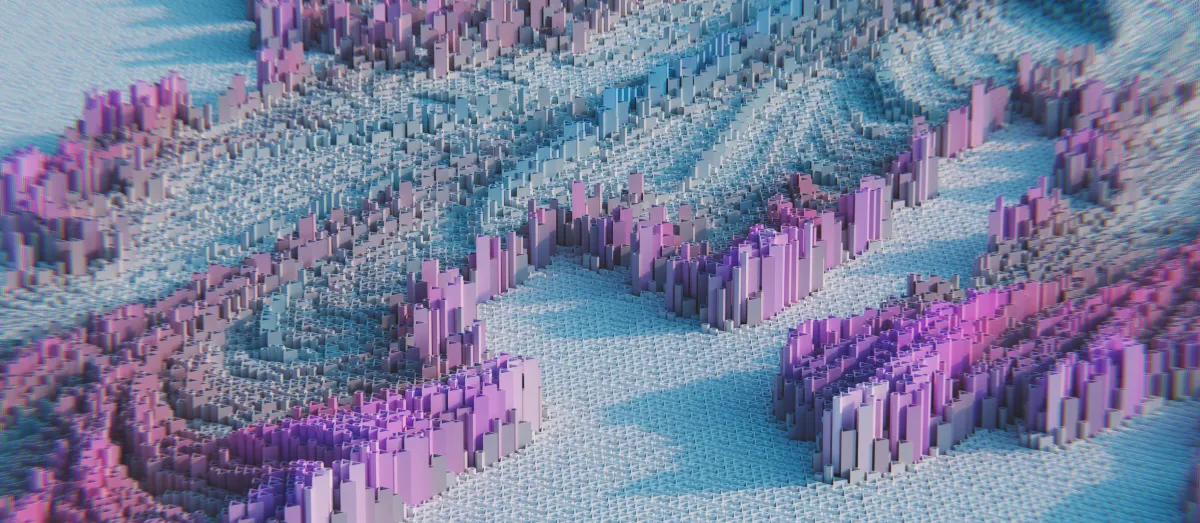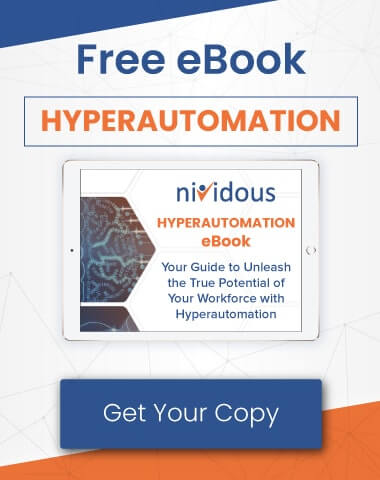AI has taken over a fascinating middle ground between complex human thought and the processing power of computers.
Businesses are rightfully enamored with AI’s ability to emulate near-human learning and thinking while accomplishing tasks with a level of speed and efficiency that humans could never hope to achieve.
But is AI truly a light at the end of the tunnel for businesses trying to slash costs and boost productivity? Or does it come with too many risks that outweigh the potential benefits?
No one truly knows the answers to these questions yet, but we can all benefit from learning about one another’s experiences with AI. As a company that specializes in helping clients implement AI solutions, we at Nividous hear plenty of these experiences every day.
Below is our take on the potential dangers of using AI for business processes and how you can minimize those threats within your workplace. After you have a plan in place, you can use our list of suggestions for common applications of AI in business to find your perfect entry point into the world of artificial intelligence.
Looking for secure and transparent AI applications? Schedule a demo to see how Nividous’ AI-backed automation platform can be customized to meet your specific business needs.
Understanding AI For Business: Risks, Rewards, And Common Use Cases
What are some of the risks inherent with business applications of AI?
Unfortunately, adopting AI in the workplace isn’t always smooth sailing. Improperly configured programs and a lack of foresight can spell major trouble for companies that don’t think through the repercussions.
Before taking the leap and adopting new AI technologies, be aware that you might introduce some new problems as well, including:
1. Insecure Data
AI models work because they ingest, interpret, and manipulate large amounts of data. As such, they are only as powerful as the data they have access to. Since the success of AI technologies relies so heavily on data, the creators of commercial AI algorithms typically try to scrape data from wherever they can. Often, this means the program will save and store whatever information a user inputs.
This is already causing trouble for some folks who use generative AI to make their jobs easier. If a programmer uses the AI program to find and solve errors by pasting snippets of proprietary business code, for example, that business’s code is now stored forever on the AI’s servers, where it could theoretically be used in suggestions for other users.
2. Bias
Entirely new companies have been formed recently to study and address the growing concerns regarding bias and fairness in AI technologies. Ethics are of particular concern in fields such as healthcare, where an AI algorithm’s decisions may influence the treatment protocols and eventual outcomes of patients.
Let’s say for example that a hospital uses AI to schedule patients for surgery based on priority. The algorithm may take into account factors such as the patient’s address, their medical history, and their age, race, and demographic information. On the surface, this seems reasonable. But what if the hospital is located in an affluent area, with the less wealthy neighborhoods on the outskirts of the city? The algorithm could prioritize those patients who live close by, since their procedures can theoretically be done quickly, and result in those who live further away having to wait for their operations.
3. Worries About Unemployment
Automation in general, and generative AI in particular, have been the subjects of plenty of angst for modern workers. As cashiers get replaced by self-checkouts and some graphic artists find themselves working for pennies because the entire world now has access to AI-designed images, it certainly appears that the worry is well-founded.
At the very least, in the cases of professions like writers, programmers, and healthcare workers, people have found their jobs dramatically altered from what they used to be in a very short time. Workers are now expected to use AI to streamline their workflows and churn out results faster than ever, which places strain on those who are slower to adapt.
4. Lack Of Transparency
This problem goes hand in hand with the issues of data security and bias above. The problem is that AI algorithms are complicated, difficult for most people to understand, and largely opaque. You’re never quite sure where the algorithm sourced its information, and therefore you’ll never know for sure whether the answers it spits out are accurate, up-to-date, ethical, or complete.
Theoretically, someone could market an AI program for general use but build it with a massive bias in one direction or the other, and it could completely change the landscape of results users receive.
How can you mitigate these risks to safely harness the power of AI applications for your business?
1. Purchase solutions from companies that believe in strict data governance.
Unfortunately, there isn’t much you can personally do to enforce good data practices for the AI algorithms you want to use in your business. These kinds of decisions are up to the creators of the AI programs. What you can do is purchase your solutions carefully and stick with trusted names for now. While we typically love to support smaller businesses, the risks of going with unproven AI solutions are great enough that we would recommend sticking to the brands you know and trust for the time being.
With that said, be aware that several of the biggest AI providers out there—ChatGPT definitely included—have run into their own legal troubles regarding data privacy and copyright infringement.
2. Look for AI solutions from companies that try to eliminate bias.
Similarly, until widespread changes in the industry are made, you’ll simply have to use AI solutions that you trust not to intentionally introduce bias into their algorithms.
Still, however, there is always a risk that the source data itself does not truly represent the wider data on a population level. Even the most ethical AI company could accidentally introduce bias by feeding its algorithm with incomplete or inaccurate data sets.
3. Encourage collaboration between humans and AI.
Nividous has worked with numerous companies to implement AI technologies into their business processes. One interesting thing we’ve noticed is that companies that combine the best of both worlds between humans and AI are reaping the greatest benefits.
AI may have the edge when it comes to speed and efficiency, but people are still in the driver’s seat when it comes to creativity and innovation.
If a company chooses to shun AI and stick to the old fashioned approach, it will likely lose a competitive edge. On the other hand, if the company fires half its staff and attempts to replace those people with automation, they’ll run into several issues as well. There are some things that humans simply do better than computers.
Thankfully, choosing how to use AI within your business is one thing that is firmly within your control. We recommend encouraging your employees to collaborate with AI as if it were an additional coworker. Assure them they will not be replaced, and put a protocol in place to help your employees learn to grow and adapt as technology continues to change the way they perform their job duties.
4. Shop for AI companies that prioritize transparency.
Finally, do your best to choose AI solutions that prioritize transparency. This is one area where ChatGPT has read the writing on the wall. Due to user complaints about not knowing how the algorithm came up with its answers, ChatGPT has recently begun listing attributions for its sources. There is still a lot of room for improvement, but it’s a step in the right direction.
If you’re shopping for the perfect AI solution and the results you’re getting feel like they’ve been spit out of an opaque black box with zero visible source material, you might want to steer clear and go with another option.
Companies that combine the best of humans and AI are reaping the greatest benefits from this technology.
Which AI business applications are making the biggest impact on businesses today?
1. Generative AI Technologies
ChatGPT has taken the business world by storm, so it’s natural that it (and other generative AI large language models like it) should top the list of transformative AI technologies.
Generative AI uses artificial intelligence to craft near-human responses to prompts. Writers can use text-based versions to brainstorm novel outlines or churn out email templates in record time, while artists can use visual versions to create dazzling images almost instantly.
Generative AI is already having quite a dramatic impact on the following industries, with dozens or hundreds more just beginning to see the benefits:
- Content Creation
- Graphic Design
- Software Development
- Healthcare
- Architecture
- Data Analysis

Ready to revolutionize your business with Generative AI?
Watch our on-demand webinar to learn how GenAI can drive innovation, reduce costs, and enhance customer experiences. Dive into real-world case studies and explore the Nividous platform demo for a comprehensive understanding.
2. AI Subspecialties
Under the umbrella of AI, several subspecialties are undergoing equally exciting advancements. As each of these subspecialties grow and change, they propel AI and automation forward as a whole. Businesses today can take advantage of fast, accurate business process automation programs by combining the following technologies:
- Machine learning: The ability for computers to learn and develop more complex algorithms as they ingest more data
- Natural language processing (NLP): The ability for computers to understand, interpret, and work with language
- Computer Vision: The ability for computers to understand and identify images, including small details within larger images
Individually they are powerful enough, but together, these technologies make complete, end-to-end automation of complex business processes possible.
3. AI Chatbots
Chatbots are software systems that simulate human conversation. One form of AI—Natural Language Processing (NLP), which allows machines to understand human language in its raw form—makes chatbots possible. But they may also use machine learning and other AI technologies to provide more accurate, relevant responses.
Chatbots are already ubiquitous in business. Go to any company website and you’re likely to see a chat window pop up. Call a customer service line and, rather than a series of interminable push-button menus, you may be treated to an interactive voice agent—a voice chatbot that uses AI to get results through language.
The reason for this widespread adoption of AI chatbots is clear: It allows companies to automate and scale customer interactions.
4. Intelligent Automation For Service Desk Processes
Information Technology (IT) departments need a centralized communications hub to serve stakeholders; that’s the purpose of a service desk. This department collects IT requests from customers, employees, and partners. It generates support tickets, assigns tasks to IT staff, tracks resolution, and communicates with stakeholders every step of the way.
In many industries, service desks receive hundreds of service requests per day. Robotic Process Automation (RPA) bots with machine learning, Computer Vision (CV), Optical Character Recognition (OCR), and NLP can categorize, process, and respond to these requests. They can generate tickets and assign them to the appropriate staff. This AI automation saves a tremendous amount of staff time on these tasks, streamlining service desk operation for greater performance and cost efficiency.
5. Invoice Data Extraction And Processing
Accounts payable departments are swamped with invoices. Smart RPA bots from use AI to identify key information on invoices, regardless of layout or format. They extract this information and enter it into accounting software and ERPs. Thanks to integrated Business Process Management (BPM) capabilities, the Nividous automation platform orchestrates work between smart RPA bots and employees to achieve total end-to-end process automation for invoicing tasks and more.
6. Insurance Claims Processing
Every insurance claim involves multiple documents, in all sorts of formats, as well as complex eligibility checks and data verifications. With AI, software can check data across documents, automating verification and other tasks associated with claims processing. Intelligent automation also reduces data errors during all these processes and dramatically reduces staff time dedicated to claims processing, saving 37,000 staff hours per year in one Nividous implementation.
Eager to transform your insurance operations with Artificial Intelligence?
Watch our on-demand webinar to discover actionable strategies on how AI and intelligent automation can empower your business to conquer soaring costs and meet the evolving expectations of customers.
7. Fraud Detection Technology
The previous examples rely largely on AI’s ability to categorize, classify, and converse, but AI is also crucial for data mining, or the discovery of useful patterns within extremely large datasets. Predictive analytics involves data mining in order to predict future outcomes—including potential fraud.
Take credit card transactions as an example. A bank can train an AI model with datasets of all its normal and abnormal transactions. That AI system can then analyze the data to reveal patterns that suggest fraudulent activity. When similar conditions arise in future transactions, the fraud detection system can notify account holders, asking for verification before processing the charge.





